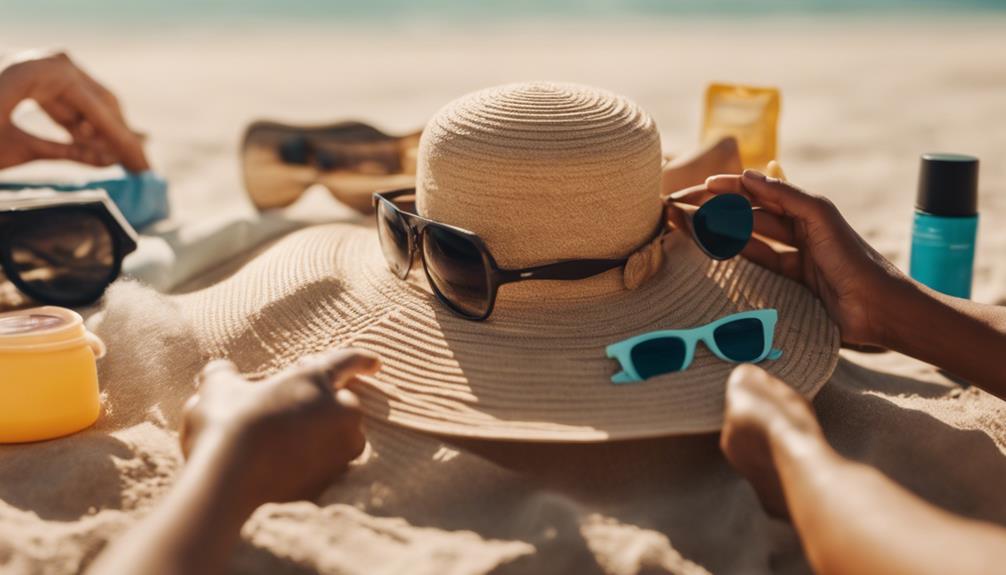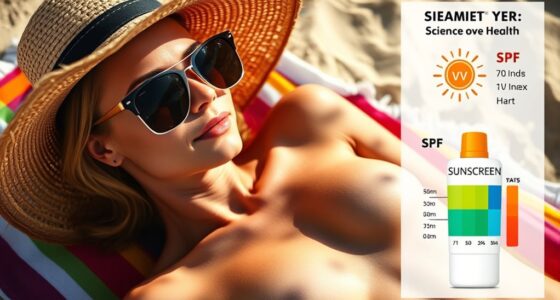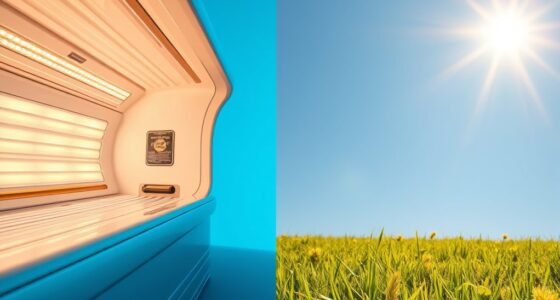A base tan isn't really protective—it's only equivalent to SPF 3-4, far below the recommended SPF 15 or higher. This false sense of security can lead you to skip sunscreen, increasing your risk of skin cancer and other damage. In fact, even indoor tanning provides minimal protection, less than SPF 1. Dermatologists stress that no tan is safe and the cumulative UV exposure greatly elevates your skin cancer risk over time. To stay safe, it's vital to understand the real dangers and take proactive measures for skin health. You might find surprising insights about sun protection and care ahead.
Key Takeaways
- A base tan offers minimal protection equivalent to SPF 3-4, far below the recommended SPF of 15.
- Relying on a base tan can lead to neglecting sunscreen, increasing the risk of skin cancer.
- Indoor tanning provides even less UV protection, equating to an SPF of less than 1.
- No tan is safe; cumulative UV damage significantly raises skin cancer risk over time.
Understanding Base Tan
A base tan might seem like a smart way to protect your skin from sunburn, but in reality, it offers only minimal protection and can lead to more harm than good. Defined as pre-sun exposure tanning, a base tan is often believed to reduce your risk of sunburn. However, it only provides protection equivalent to an SPF of 3-4, which is far from adequate. This misconception encourages you to spend more time in the sun, increasing your skin cancer risk and exposing you to harmful UV radiation.
Dermatologists emphasize that any form of tanning—whether from natural sunlight or tanning beds—causes skin damage. Although a base tan may allow you to stay outside a bit longer before burning, it still results in significant skin harm over time.
Relying on a base tan leads many to neglect the importance of sunscreen, which is essential for effective sun protection. Broad-spectrum SPF 30 or higher is recommended to shield your skin from both UVA and UVB rays.
Health Risks of Tanning

When you think about tanning, it's easy to overlook the serious health risks involved.
Many people believe a base tan offers protection, but that misconception can put you at greater risk for skin cancer.
Understanding the real dangers of UV exposure is essential for your long-term skin health.
Increased Skin Cancer Risk
Tanning greatly raises your risk of developing skin cancer, with a single blistering sunburn nearly doubling your chances of melanoma. The reality is that both outdoor tanning and indoor tanning expose your skin to harmful UV rays. A staggering number of nearly 5 million people in the U.S. are treated for skin cancer each year, and this number is climbing due to increased UV exposure from tanning practices.
If you think a base tan offers protection, think again. Overexposure to UV rays doesn't just lead to immediate skin damage; it contributes to long-term health risks, including premature aging and various skin conditions. The dangers of indoor tanning are especially alarming, as using tanning beds before age 35 can increase your melanoma risk by a shocking 75%.
To protect yourself, make sun protection a priority. Always apply sunscreen with a high SPF, reapply regularly, and seek shade whenever possible. Remember, your skin's health is worth more than a temporary tan. Taking these precautions can greatly reduce your chances of developing skin cancer and maintain the health of your skin for years to come.
Misconceptions About Protection
Many people believe that a base tan can protect their skin from sunburn, but this misconception can lead to harmful consequences. A base tan provides minimal protection, with an estimated SPF of less than 4, which is hardly enough to keep you safe from UV exposure. Indoor tanning is even worse, clocking in at less than 1 SPF. This false sense of security often makes you skip sunscreen, putting your skin at greater risk.
Cumulative damage from UV exposure over the years greatly increases your risk of skin cancer. Relying on a base tan can create a dangerous cycle where you expose yourself to more sun, thinking you're protected. Studies show that a single blistering sunburn can nearly double your lifetime risk of melanoma, highlighting just how risky it's to depend on a base tan.
Instead of trusting these misconceptions, it's essential to use sunscreen whenever you're outside, regardless of your tan. Remember, the best protection comes from being proactive about your skin health, not from a misleading belief in a base tan's effectiveness.
The Myth of Protection

The belief that a base tan offers significant protection against sunburn is a dangerous myth that can lead to harmful sun exposure. In reality, a base tan provides minimal protection, with an estimated SPF of only 3-4.
That's far lower than the recommended SPF of at least 15 for effective sun protection. While you might think a base tan allows for longer sun exposure before burning, it doesn't prevent skin damage or reduce the risk of skin cancer.
Many people fall into the trap of thinking that a base tan means they can skip sunscreen, but this misconception can increase the risk of serious skin issues down the line. Indoor tanning salons offer even less protection, equating to an SPF of less than 1, which fails to prevent sunburn effectively.
It's essential to understand that relying on a base tan as a form of protection can lead to neglecting proper sun safety measures. The risks associated with prolonged sun exposure, coupled with these misconceptions, make it important for you to prioritize effective sun protection strategies instead.
Tanning Among Teens

Outdoor sun exposure and indoor tanning among teens can lead to severe long-term skin damage and an increased risk of skin cancer. The American Academy of Dermatology warns that early tanning greatly raises your lifetime risk of developing skin issues.
Despite recent declines in indoor tanning rates—from nearly 16% in 2009 to just over 7% in 2015—about 1 million teens in the U.S. still choose to tan indoors. This highlights the urgent need for enhanced awareness and prevention programs focused on sun safety.
While 42 states now have restrictions on indoor tanning for minors, the risks remain considerable, especially for young skin that's still developing. These programs aim to educate you about the dangers of UV radiation, helping you make informed choices. Even if parental consent is involved, it's crucial to understand that there's no safe way to tan.
As a teen, you have the power to prioritize your skin health. Embracing sun safety practices and avoiding indoor tanning can protect your skin from irreversible damage and reduce the risk of skin cancer later in life. Stay informed and make choices that'll benefit you in the long run.
Vitamin D Considerations

Getting enough vitamin D is important for your health, but you don't have to rely on sun exposure to achieve those levels. While limited sun exposure can help boost vitamin D, excessive sun exposure increases health risks like skin damage and skin cancer. It's essential to find a balance.
Here's a quick comparison of vitamin D sources:
| Source | Benefits |
|---|---|
| Sun Exposure | Natural source, but risky |
| Fatty Fish | Rich in vitamin D and omega-3s |
| Fortified Dairy | Convenient and widely available |
| Supplements | Controlled dosage without UV risks |
| Tanning (Avoid) | Increases risk of skin damage |
Public health messages encourage you to explore alternative sources of vitamin D, which can help you maintain healthy levels without the dangers of UV radiation. You can enjoy the benefits of vitamin D while minimizing the potential for skin damage and skin cancer. By choosing safer options, you can protect your skin while still supporting your overall health. So, don't rely solely on tanning or sun exposure—explore these alternative sources for your vitamin D needs.
Safe Sun Practices

Practicing safe sun habits can greatly reduce your risk of skin damage while still allowing you to enjoy time outdoors.
Start by using a broad-spectrum sunscreen with at least SPF 30. Apply it generously and reapply every 2-3 hours, especially during outdoor activities. This guarantees you're protected against harmful UV exposure.
In addition to sunscreen, consider wearing protective clothing, like long sleeves and wide-brimmed hats, which can considerably lower your risk of sunburn and skin cancer.
It's also wise to avoid the sun during peak hours, from 10 a.m. to 3 p.m., when UV rays are most intense.
Remember, a base tan isn't a safe alternative to sunscreen; it doesn't provide adequate protection.
Instead, prioritize proactive skin health by scheduling regular skin checks with a dermatologist. They can help detect early signs of skin damage or cancer, reinforcing the importance of taking care of your skin.
Frequently Asked Questions
How Long Does a Base Tan Last?
A base tan typically lasts about 10 to 30 days, depending on your skin type and tanning extent. It fades at a rate of 1 to 2 shades weekly without further tanning or exposure.
How Much Protection Does a Tan Give?
A tan offers minimal protection, roughly equivalent to SPF 3-4. You can only extend sun exposure slightly, making it essential to still apply a higher SPF sunscreen to effectively shield your skin from harm.
How Long Should I Lay Out to Get a Base Tan?
You might need 20-30 minutes of sun exposure to start developing a base tan, but remember, any tan signals skin damage. It's safer to use broad-spectrum sunscreen instead to protect your skin!
Does a Fake Tan Protect You From the Sun?
No, a fake tan doesn't protect you from the sun. It lacks SPF and doesn't block UV rays. Always apply sunscreen, even when using sunless tanning products, to keep your skin safe from damage.
How Effective is a Base Tan for Sun Protection Compared to Other Methods?
A base tan is not an effective method for ultimate sun protection every season. It only provides minimal protection from UV rays, and can lead to skin damage and an increased risk of skin cancer. Using sunscreen, wearing protective clothing, and seeking shade are much more reliable methods for sun protection.
Conclusion
So, if you think that a base tan is your golden ticket to sun safety, think again!
Sure, it might give you that sun-kissed glow, but it won't save you from the dangers of UV rays.
Instead of chasing the elusive 'perfect tan,' why not embrace your natural skin tone?
After all, who needs a bronze glow when you can have healthy skin?
Put down the tanning oil and pick up some sunscreen; your future self will thank you!








